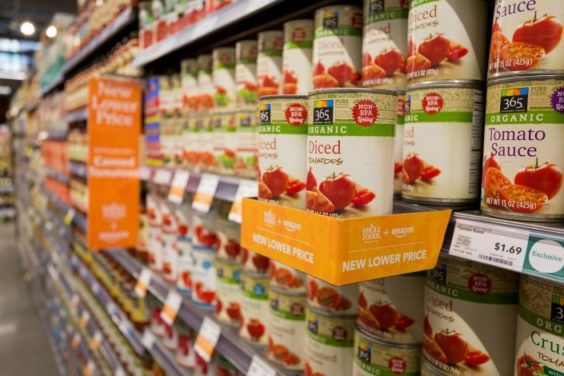
When Amazon bought Whole Foods Market last year, retail pundits predicted a grocery industry earthquake. Neighborhood stores would be shuttered, we’d all suddenly develop a taste for overpriced kale and arugula, and we’d no longer leave the house, instead happily sitting at home ordering our groceries from the comfort of our computer.
But a surprising thing happened on Amazon’s way to taking over the grocery world. Instead of immediately running mediocre grocery competitors out of business, Amazon has actually made them better.
That’s according to the newest annual American Customer Satisfaction Index, which gauges shoppers’ opinions of their most-frequented stores.
What the survey found was that it’s tough out there for department and discount stores like Target, Walmart, Sears and Dollar General. Customer satisfaction declined nearly across the board with retailers in that category, suggesting that in their case, “signs of the retail apocalypse have not been exaggerated,” ACSI declared.
But things are looking rosier for grocery stores. Two years after falling to the lowest level in more than a decade, shopper satisfaction with their local grocery stores increased in 2017 for the second year in a row. This “shows how companies are focusing on customer satisfaction as one way to ward off Amazon’s push into new retail industries,” said ACSI Managing Director David VanAmburg.
So instead of driving them into the ground, Amazon’s expansion into groceries has apparently motivated the rest of the industry to do better – because they may not have much of a choice.
“The threat of competition from Amazon’s entry into the market appears to have spurred grocery stores to bolster their offerings,” the report reads. “Supermarkets in just about every price range now focus more on organic and natural products. They have also expanded the selection of prepared food. Higher quality products and better customer service is driving customer satisfaction up nearly across the board for supermarkets.”
As they do each year, ACSI researchers surveyed thousands of grocery shoppers across the country, asking them to rank their local stores on a scale of 0 to 100, on attributes like convenience, quality, cleanliness and cost. Those numbers were combined into an overall score for each retailer. Grocery stores as a whole earned a 79 out of 100, up one point from last year. Some stores did better, others not so much. Here’s a look at the 22 stores rated in this year’s survey, along with each store’s customer satisfaction ranking:
1. Publix (86)
For the first time since 2013’s ACSI survey, Publix is back on top, with the same strong score of 86 it had back then. 2013 marked the end of Publix’s amazing 19-year run atop the list, a record that was accompanied by a bit of an asterisk – neither Trader Joe’s, Wegmans nor H-E-B were included in the survey back then. In 2014, they were – and the popular stores promptly ganged up on Publix and bumped it down to a tie for number three. Now, even in the face of this strong competition, Publix has finally earned the top spot in its own right.
2. Trader Joe’s (85)
Last year’s favorite slipped by a point and fell to number two. “While Trader Joe’s was unable to sustain its record-high score from last year, customer satisfaction with the grocer is still extremely high for a brick-and-mortar retailer, on par with Amazon’s score in the internet retail category,” VanAmburg said.
3. ALDI/Wegmans (tie, 84)
Shopping at ALDI and shopping at Wegmans are two very different experiences. Wegmans is a foodie favorite, while ALDI is a no-frills discounter. But the two have one thing in common – they’re both apparently very good at what they do. Both were up one point from last year, landing in the top tier of favorite grocery stores.
5. Costco/H-E-B (tie, 83)
Club stores were included in ACSI’s grocery ranking for the first time this year. And Costco makes a respectable debut, tied for number 5 with fan favorite H-E-B.
7. Sam’s Club (82)
Not to be outdone, Costco competitor Sam’s Club is just one point behind. With an eye toward Amazon – and Costco – Sam’s just became the latest retailer to enter the same-day delivery wars, announcing a partnership with Instacart to begin grocery delivery in a handful of markets.
8. Hy-Vee/Kroger/Whole Foods/”All others” (81)
Speaking of Amazon, you might think its Whole Foods Market would have fared better than plain-vanilla Kroger, Hy-Vee and “all other” grocery chains that were too small or had too few survey results to be ranked separately. If it’s all about Amazon, shouldn’t Whole Foods be at the top of the list? “It’s too soon to gauge the effect of its acquisition by Amazon, which only recently began rolling out Whole Foods deliveries,” the ACSI report reads. A score of 81 isn’t shabby, but watch to see whether Whole Foods rises up the rankings in future surveys.
12. BJ’s Wholesale Club (80)
Another club store makes a showing on the list, this one in the middle of the pack. BJ’s earned a score of 80 – despite its appeal to couponers, as the only one of the major membership warehouse clubs that accepts all manufacturer’s coupons.
13. Ahold Delhaize/Meijer/ShopRite/Target (tie, 79)
Target has been devoting a lot of time and effort to “reimagining” its stores and its grocery selection, but it’s still stuck in the lower half of the ACSI survey, lumped in with the likes of ShopRite, Meijer and Ahold Delhaize. But don’t diss Ahold Delhaize, which owns Food Lion, Hannaford, Giant and Stop & Shop – it must be doing something right, since it experienced the greatest improvement in the survey this year, up three points from its poor showing last year.
17. Southeastern Grocers (78)
Southeastern Grocers owns BI-LO, Winn-Dixie and Harveys, and there’s been talk that it may be filing for bankruptcy and shutting down a slew of stores any day now. With a strong competitor like Publix eating away at its market share throughout the South, whatever Amazon might be doing is the least of this company’s problems.
18. Supervalu (77)
Supervalu used to be a grocery powerhouse, but after selling off Albertsons and many other holdings several years ago, it’s now primarily a grocery wholesaler that owns a few regional chains. It’s doing a lot better in the wholesale business than it is running grocery stores, so some investors are pushing for the company to get out of the retail business altogether. And with this showing in the ACSI survey, can you blame them?
19. Albertsons, Giant Eagle, Save-A-Lot (tie, 76)
If it’s any consolation, Supervalu is doing better than the stores that it sold. It used to own both Albertsons and Save-A-Lot, which show up in this year’s rankings one notch below their former master. And Giant Eagle, which tied for last place last year, managed to emerge from the cellar – just barely – for a second-to-last-place tie.
22. Walmart (73)
And last place is perhaps not a surprise. Walmart sank by a point to round out the list with a score of 73. It’s held this bottom spot in the ACSI grocery rankings for 13 consecutive years. So at least there’s something to be said for consistency.
Overall, grocery stores did as well or better than they did last year in every attribute the ACSI survey ranked. Shoppers gave their stores a score of 85 for convenience, and an 83 for the quality and freshness of food. Further down the list, “frequency of sales and promotions” got a 79, which was still up two points from last year. And “speed of checkout process” was ranked last, with a score of 76.
So maybe there’s something to be said for Amazon and grocery deliveries after all. Speed of checkout isn’t a problem when you never have to visit a grocery checkout at all. By the time next year’s survey comes around, we may have an even better idea whether Amazon/Whole Foods will surpass all competitors – or whether it will continue to prod them all to get even better.
Image source: Whole Foods Market










